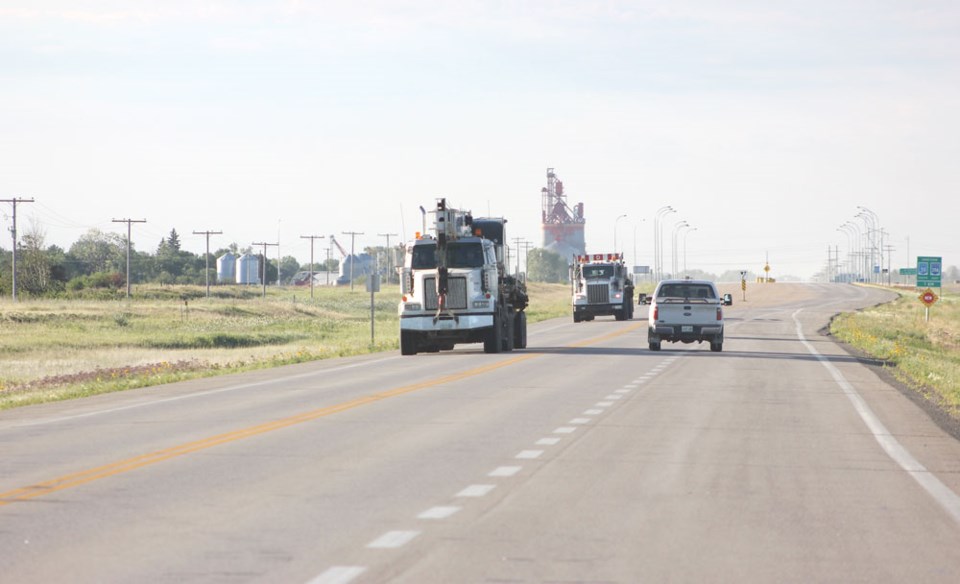The provincial government has decided it will proceed with passing lanes on Highways 39 and 6 from Estevan to Regina.
David Marit, the provincial minister of Highways and Infrastructure, said in an interview with the Mercury last week that the government is moving forward with passing lanes as a short-term solution.
“We’re seeing a huge increase in traffic, and twinning is very expensive,” Marit said. “If you had done it in five years, it would be a miracle. We can virtually have the passing lanes done (in that time), once we get some of the planning done, and where we think we can go.”
Marit’s revelation comes nearly four years after Premier Brad Wall announced the provincial government would move forward with twinning Highways 39 and 6 from Estevan to Regina.
The government held several meetings and open house sessions to discuss the project, and revealed designs for the twinned highways at open houses in 2015.
But the provincial budgets in 2016 and 2017 stated the government was looking at a combination of twinning and passing lanes for the two highways, raising concerns among local residents who wanted to see the highways twinned.
“I think we can alleviate a lot of our pressure with the passing lanes,” said Marit.
The concept of passing lanes has drawn skepticism and even anger from local residents in the past, most notably from the local Time to Twin committee, which wants to see double lanes all the way from North Portal to Regina.
Time to Twin committee co-chair Marge Young wasn’t able to comment when contacted by the Mercury, but said she would make a statement in the future.
Marit believes there would be 15 sets of passing lanes between Estevan and Regina. The passing lanes would be around two kilometres in length, although they might be closer to 2 1/2 kilometres long in some areas.
“We’re proving they work well,” said Marit. “We know from Fort Qu’Appelle to Regina (on Highway 10) what they have done. We know from Saskatoon to Rosetown (on Highway 7) what they have done.”
Marit believes the length of the passing lanes gives people enough time to get past the heavy trucks. And the passing lanes mean motorists shouldn’t be as aggressive to pass heavy trucks and slow-moving traffic on normal stretches of the highways.
He stressed the government has to seriously look at the traffic in five different corridors in the province, and the one from Regina to Estevan is one of the two that needs to be addressed the most.
Passing lanes won’t be located in random locations either, he said. The government needs to look at the road allowance structure and utility line locations, and they need to discuss the concept with affected urban and rural municipalities on where they believe the passing lanes should be located.
“In some cases, we may have to ask the RMs to close a road because it’s the best place for it (a passing lane),” said Marit.
Those discussions will begin this fall.
The timelines for the passing lanes will hinge on the budget, he said.
“Depending on the budget and dollars and what we get allocated next spring, I’m hoping that within the next couple of years, we can see some passing lanes along that corridor,” said Marit.
The government needs to determine where construction of passing lanes will begin. It would take a lot of construction and money to complete the passing lanes in a year.
Information gained during the planning meetings that the ministry had when they were looking at twinning can be used for the twinning project, he said. Marit anticipates the meetings they will have now will focus on the municipalities.
Marit also noted the bypasses that were planned for Midale, Halbrite, Weyburn and Yellow Grass as part of the twinning project are now on hold.
“I had a very good discussion with the city of Weyburn and the chamber a few months ago,” said Marit. “They obviously are very concerned about a bypass and what it would do to them, and where would we put it, and how it would impact future growth.”
The passing lane announcement doesn’t affect the twinning project that is currently underway east of Estevan to an area south of the junction with Highway 18. That project is proceeding, and is scheduled to be finished late this year.
A decision hasn’t been made on whether passing lanes will be constructed closer to the Canada-U.S. border crossing at North Portal.
“It probably would be in our best interest to seriously look at that if we still see those traffic volumes at the border as well,” said Marit.
Marit and representatives of the Saskatchewan Ministry of Highways and Infrastructure discussed the plans for the future of Highways 39 and 6 during a meeting with a committee promoting safety on Highway 52 in North Dakota and a representative of the North Dakota Department of Transportation.
“I think their concern was what were our future plans for that corridor,” said Marit. “They were under the assumption that we were going to twin, because we’re twinning just east of Estevan.”
The provincial ministry responded that they’re not looking at twinning most of the highway at this time. Instead, Marit talked to them about the passing lanes option.
“They were very appreciative of that and the discussion, because, obviously, if we had twinned it, it really would have put pressure on their system also,” said Marit. “They were concerned because it wasn’t in their plans, or their immediate future at all, to twin that highway.”
Marit predicted that after the discussion they had, the Americans would have a serious look at installing passing lanes on Highway 52.
He said the two sides will meet again to talk about issues facing highways on both sides of the border, including weight compliance, truck dimensions and other issues, since it is the largest trading corridor in the province.



